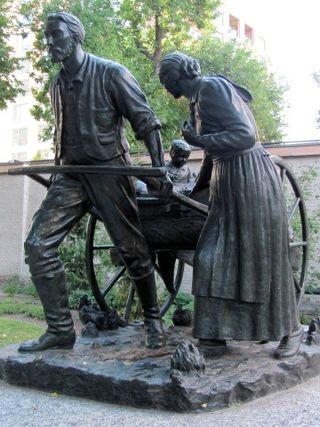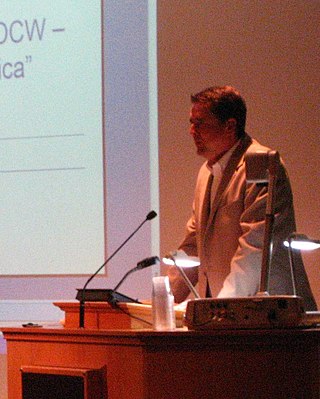
Excommunication is an institutional act of religious censure used to deprive, suspend, or limit membership in a religious community or to restrict certain rights within it, in particular those of being in communion with other members of the congregation, and of receiving the sacraments.

Richard Roswell Lyman was an American engineer and religious leader who was an apostle in the Church of Jesus Christ of Latter-day Saints from 1918 to 1943.
Dennis Michael Quinn was an American historian who focused on the history of The Church of Jesus Christ of Latter-day Saints. He was a professor at Brigham Young University (BYU) from 1976 until he resigned in 1988. At the time, his work concerned church involvement with plural marriage after the 1890 Manifesto, when new polygamous marriages were officially prohibited. He was excommunicated from the church as one of the September Six and afterwards was openly gay. Quinn nevertheless identified as a Latter-day Saint and continued to believe in many LDS teachings, though he did not actively practice the faith.
Lavina Fielding Anderson was a Latter-day Saint scholar, writer, editor, and feminist. Anderson holds a Ph.D. in English from the University of Washington.
The Mormon Alliance was founded on July 4, 1992 by Paul Toscano to counter perceived spiritual and ecclesiastical abuse in the Church of Jesus Christ of Latter-day Saints and to protect the Church against defamatory actions. During the next few months, the trustees established a broad range of supporting purposes: providing a comprehensive definition of spiritual abuse, working to reconcile leaders and members who were out of harmony, establishing a Members’ Bill of Rights, providing a forum for a reasonable and tempered discussion of governance in the Church, critiquing general conference, and identifying and documenting cases of spiritual and ecclesiastical abuse. Janice Merrill Allred and Lavina Fielding Anderson, two of the trustees, became co-chairs of the Case Reports Committee in the fall of 1992 and still serve in those positions. Toscano and Fielding Anderson were excommunicated by the Church following their actions.
Grant Hart Palmer was an American educator best known for his controversial work, An Insider's View of Mormon Origins, which ostensibly led to his disfellowshipment in 2004 from the Church of Jesus Christ of Latter-day Saints.

The Mormon religion is predicated on what are said to be historical events such as the First Vision of Joseph Smith and the historicity of the Book of Mormon, which describes a detailed pre-Columbian history of the Americas. Joseph Fielding Smith, the tenth president of the Church of Jesus Christ of Latter-day Saints, declared that "Mormonism, as it is called, must stand or fall on the story of Joseph Smith. He was either a prophet of God, divinely called, properly appointed and commissioned, or he was one of the biggest frauds this world has ever seen. There is no middle ground." As Jan Shipps has written, "Mormonism, unlike other modern religions, is a faith cast in the form of history," and until after World War II, Mormons did not critically examine the historical underpinnings of their faith; any "profane" investigation of the church's history was perceived "as trespassing on forbidden ground."

Avraham Gileadi is a Dutch-born American scholar and professor specializing in the Hebrew language and analysis of Book of Isaiah. A longtime professor at Brigham Young University, he was one of the "September Six" of prominent scholars excommunicated by the Church of Jesus Christ of Latter-day Saints in 1993, but several years later Gileadi was formally readmitted into the church and insists that his excommunication was recognized by church leadership as "a mistake".

George Patrick Lee was the first Native American to become a general authority of the Church of Jesus Christ of Latter-day Saints. He was a member of the church's First Quorum of Seventy from 1975 to 1989, when he was excommunicated from the church.
The Strengthening Church Members Committee is a committee of general authorities of the Church of Jesus Christ of Latter-day Saints who monitor the publications of its members for possible criticism of general and local church leaders. If criticism is found, the committee may forward information to local church leaders, who may bring charges of apostasy, which can result in excommunication.

John Parkinson Dehlin is an American podcast host. He holds a PhD in psychology. Dehlin founded the Mormon Stories Podcast, as well as several other Mormon-themed podcasts, blogs, and web sites. He was an influential early participant in the Mormon blogosphere, and blogs at Patheos.com. He has advocated for the rights of skeptics in Mormonism, LGBT rights, equality for women, and other individual views outside mainstream Mormonism.
Paul L. Anderson was a member of the Church of Jesus Christ of Latter-day Saints. He was an architectural historian, museum curator and hymnwriter.
Peggy Fletcher Stack is an American journalist, editor, and author. Stack has been the lead religion writer for The Salt Lake Tribune since 1991. She and five other journalists at the Salt Lake Tribune won the 2017 Pulitzer Prize for Local Reporting. She won the Cornell Award for Excellence in Religion Reporting—Mid-sized Newspapers from the Religious News Association in 2004, 2012, 2017, 2018, and 2022.

Latter-day Dissent: At the Crossroads of Intellectual Inquiry and Ecclesiastical Authority is a 2011 book edited, with an introduction, by Philip Lindholm. It chronicles the stories of prominent LDS intellectuals who faced disciplinary action by the LDS Church. The book features contributions from members of the September Six, including Lynne Kanavel Whitesides, Paul Toscano, Maxine Hanks, Lavina Fielding Anderson, D. Michael Quinn, as well as Janice Merrill Allred, Margaret Merrill Toscano, Thomas W. Murphy, and Donald Jessee. Lindholm's analysis combined with Diarmaid MacCulloch's foreword and the interviews themselves collectively discuss the nature and extent of intellectual freedom and disciplinary action in the LDS Church.
Denver Carlos Snuffer Jr. is a Utah lawyer, an author of Restorationist devotional books, a lecturer, a speculative theologian, and claims to be a “revelator to fellowships of the remnants movement,” a spiritual movement in schism with the Church of Jesus Christ of Latter-day Saints. The movement has a few thousand adherents, many of them members or former members of the LDS Church. He was excommunicated by the LDS Church in 2013 for refusing to cease publication of his 2011 book, Passing the Heavenly Gift which challenges many points of LDS orthodoxy. He subsequently has been identified as a prophet by many, and several of his teachings have been canonized as scripture.
Ordain Women is a Mormon feminist organization that supports the ordination of women to the priesthood in the Church of Jesus Christ of Latter-day Saints. It was founded on March 17, 2013, by Kate Kelly, a human rights attorney from Washington, D.C., with the website launch containing 19 profiles of individuals calling for the ordination of Mormon women. As of May 17, 2014, the website featured more than 400 profiles.
Mormon feminism is a feminist religious social movement concerned with the role of women within Mormonism. Mormon feminists commonly advocate for a more significant recognition of Heavenly Mother, the ordination of women, gender equality, and social justice grounded in Mormon theology and history. Mormon feminism advocates for more representation and presence of women as well as more leadership roles for women within the hierarchical structure of the church. It also promotes fostering healthy cultural attitudes concerning women and girls.
Janice Merrill Allred is an excommunicated Latter Day Saint, theologian, writer, and Mormon feminist. She was born in Mesa, Arizona.
This is a bibliography of literature treating the topic of criticism of Mormonism, sorted by alphabetical order of titles.
This is a timeline of LGBT Mormon history in the 1980s, part of a series of timelines consisting of events, publications, and speeches about LGBTQ+ individuals, topics around sexual orientation and gender minorities, and the community of members of the Church of Jesus Christ of Latter-day Saints. Although the historical record is often scarce, evidence points to queer individuals having existed in the Mormon community since its beginnings. However, top LDS leaders only started regularly addressing queer topics in public in the late 1950s. Since 1970, the LDS Church has had at least one official publication or speech from a high-ranking leader referencing LGBT topics every year, and a greater number of LGBT Mormon and former Mormon individuals have received media coverage.





